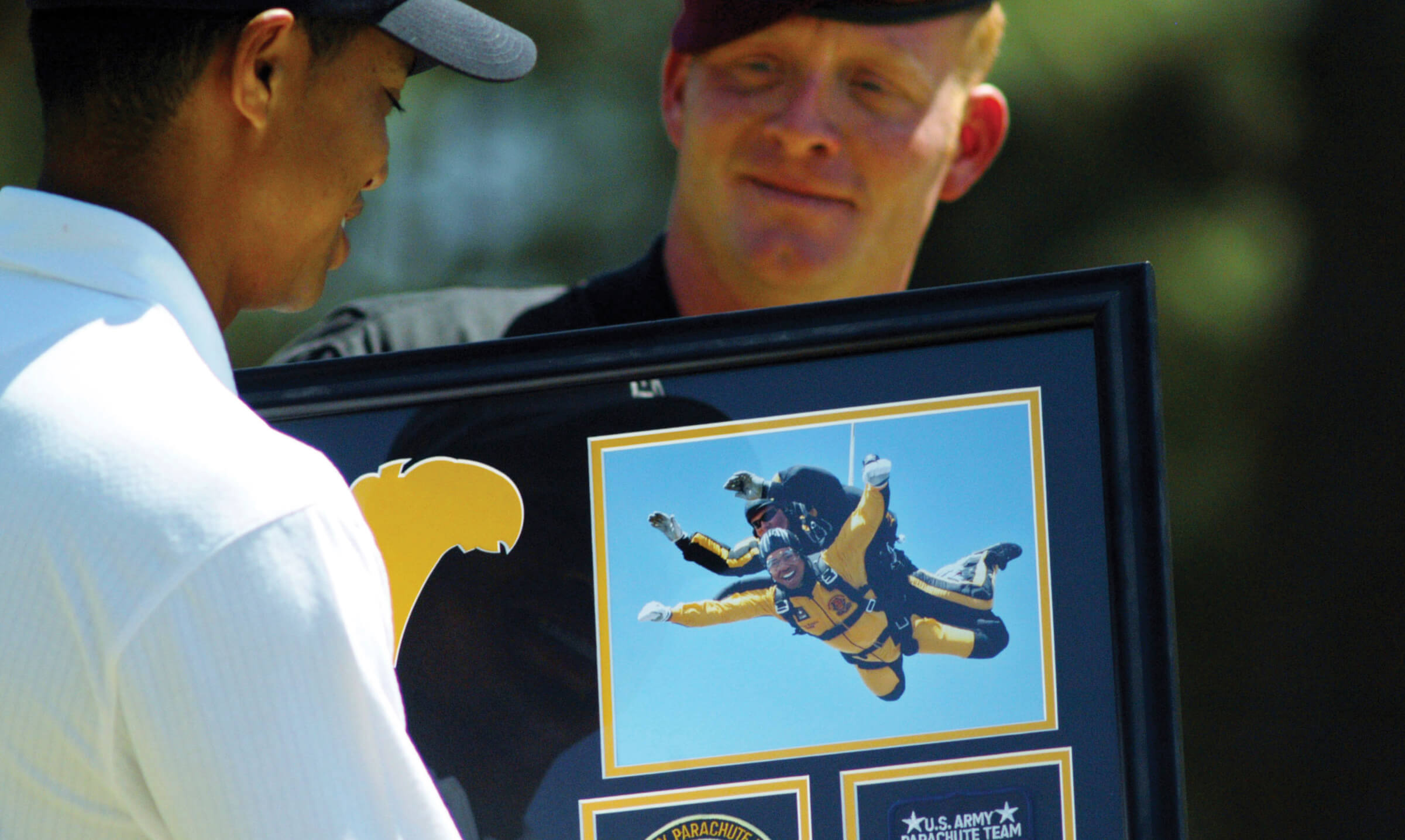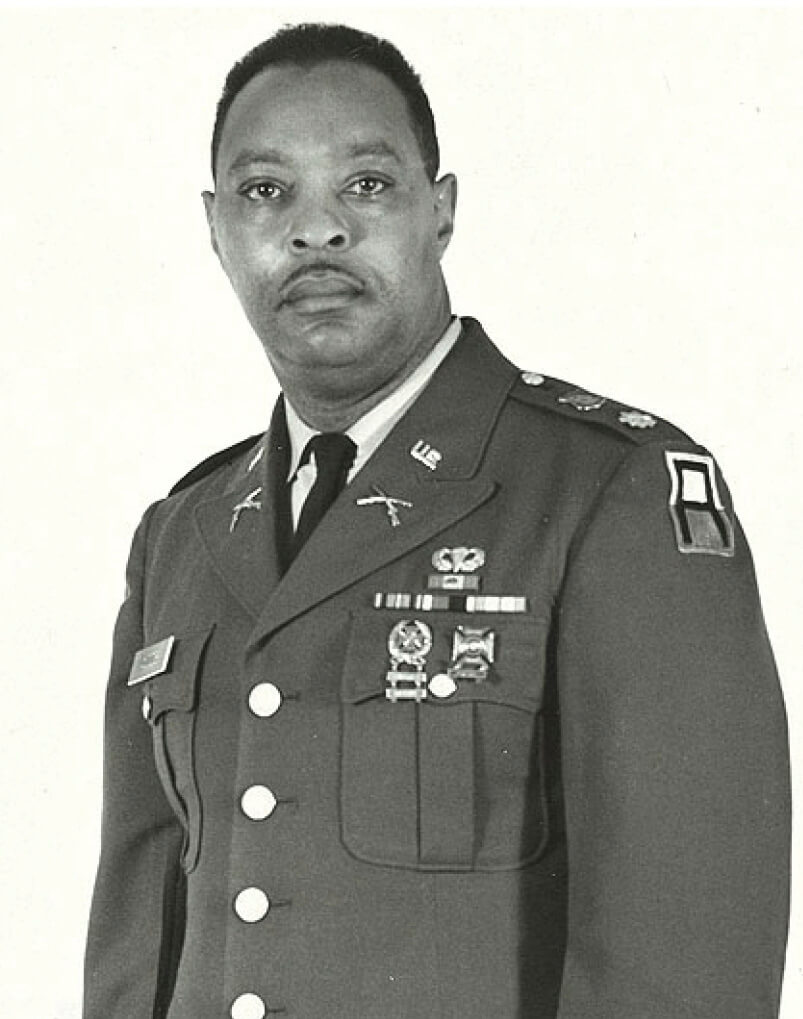BONUS CONTENT/FEATURE STORY
Tiger, Tiger
In April 2004, Tiger Woods, then 28 and already a superstar in the golf world, headed to the United States Army garrison in Fort Bragg, North Carolina. He wanted to better understand what his father, Earl, had gone through to train at that very camp as a Green Beret during the Vietnam War, and also to honor the active-duty soldiers there. In this excerpt from bestselling author James Patterson, Tiger and his father find another tie to help build their father-son relationship.

Tiger Woods is presented with a photo of him parachuting, before his golf exhibition in 2004 at Fort Bragg.
TIGER IS THE ONLY soldier reporting for duty in a private jet. After touching down at Pope Air Force Base, he makes a quick transfer to Fort Bragg [now Fort Liberty], where he’s issued a camouflage uniform tagged with his name, then meets the troops and is briefed on the installation where his father, Earl, trained between his two Vietnam tours, in 1963 and 1970.
Earl and several of his old Special Forces buddies accompany Tiger to the base. “It was the thrill of a lifetime for me,” Tiger says. “To see my father’s group, the ‘Sixth Group,’ which no longer exists in Green Berets, to see some of the guys my dad served with in Nam, man that was really cool.”
“Tiger’s interest in exploring the military firsthand means a great deal to me, especially since he’s chosen my former training ground,” his father says. “I will not be with him during his training exercises,” Earl, who totes an oxygen tank these days, notes dryly. “But I’ll have plenty to talk to him about when he finishes.”
Fort Bragg spokesman Lieutenant Colonel Billy Buckner admits that Tiger isn’t getting the full military experience. “He’s not going to have a drill sergeant barking up and down at him and yelling at him to get in line,” Buckner says, but he will “get some exposure and experience with how Special Forces operators conduct business.”
“If I was never introduced to golf, I would be doing something like that,” Tiger says in agreement. “Hopefully, something in the Special Ops arena. It’s the physical and mental challenge of it all. We’ll see what happens.”
Earl is curious, too. Tiger, he says, is “a very independent individual, and he plays an individual sport. Quite frankly, he’s not in the business of people telling him what to do.” Tiger, Earl declares, will “learn an awful lot about himself, and how he can handle it. He’ll come out a lot stronger than he went in.”

Earl Woods served two combat tours in Vietnam, and retired as a lieutenant colonel
Physical training begins that Tuesday. At 6:30 a.m. Tiger joins four hundred members of the Eighteenth Airborne Corps on a four-mile cadence-call run in full uniform, including boots. It’s not too far removed from the way he trains at home. “The only difference [in the run] was yelling at the top of my lungs and singing along with the guys,” Tiger says. “I’m used to running alone with my MP3 player.”
He completes the run in just over 31 minutes—besting the standard time by four minutes. “Everyone was impressed with his physical abilities,” Lieutenant Colonel Buckner says. “He’s a good soldier.”
“There’s no physical challenge in golf,” Tiger tells the Associated Press. “We walk around for four and a half hours. That’s not tough. . . . These guys run miles upon miles carrying a 40-pound sack and two quarts of water and flannel and rifles. That’s tough.”
His job doesn’t compare. “I’m just trying to hit the ball into a little bitty cup that’s 400 yards away. These people here are putting their lives on the line. That to me is the ultimate dedication.”
At 13,500 feet, Tiger is tethered to Billy Van Soelen, an instructor with the Golden Knights, an elite army parachute team that’s also done tandem jumps with celebrities such as Chuck Norris and former president George H. W. Bush. An army photographer captures Tiger in midair, smiling in his yellow jumpsuit and goggles, arms outstretched in flight. He completes two tandem jumps, saying, “It’s an experience I’ll never forget. You’re going 120 miles per hour, but it still feels like you’re floating.”

“It’s an honor to walk in my father’s footsteps by training with the service men and women at Fort Bragg. It’s not that I didn’t understand what my dad did, but to physically see what he did just shed a whole new light on it.”
—Tiger Woods, reflecting on the service of his dad, Earl
“I was so excited. I couldn’t wait to go,” Tiger says of the parachuting experience. “I’m one of those people who love to ride roller-coasters, so to me it’s like the ultimate roller-coaster.”
Earl waits for Tiger in the drop zone, and they embrace.
“Now you understand my world,” Earl says. But these daytime jumps are a far cry from those done under pitch-black combat situations. “Your dad was doing tactical jumps,” Van Soelen tells Tiger. “This is Hollywood.”
“It’s an honor to walk in my father’s footsteps by training with the service men and women at Fort Bragg,” Tiger says of his experience. “It’s not that I didn’t understand what my dad did, but to physically see what he did just shed a whole new light on it.”
He ends his week by hosting the Tiger Woods Foundation’s thirtieth Junior Golf Clinic and a golf exhibition on the base, which is equipped with a top golf course: Stryker, designed in 1948 by famed architect Donald Ross. Tiger emerges from his army crash course to lead a clinic on April 16 for seventy-six young golfers—giving one-on-one instruction to eight of them—then put on a skills exhibition at the 13th hole for 4,300 soldiers and their families, impressing them with a variety of shots, including a live rendition of his famous Nike ad, bouncing a golf ball on his wedge.
“He’s giving something back to the community,” says a local coach. “I wish more golfers would give more back.”
Tiger’s taking with him valuable lessons learned—about the military, about himself, about his father. A Stryker Golf Course member who, like Earl, served as a Green Beret in Vietnam assesses the impact of Tiger’s military training. “He’s in good shape and he’s young,” the retired officer says. “It won’t hurt him.”
Excerpted from Tiger, Tiger by James Patterson. Copyright © 2024 by James Patterson.